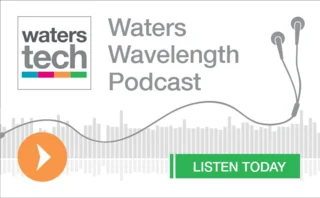CAT Needed Now More Than Ever
The Consolidated Audit Trail is exactly what the industry needs right now.

I was talking with Waters’ US editor Anthony Malakian on a recent episode of the Waters Wavelength, our weekly podcast that runs every Thursday on our website, iTunes and SoundCloud, when the topic of Navinder Singh Sarao came up.
Sarao is the now-infamous British day trader whose spoofing led to the 2010 Flash Crash, according to some. Anthony found this egregious. Some exhaustive studies on the Flash Crash have found no evidence that Sarao was the sole cause of the market dive. It’s still unclear what exactly triggered it. Still, citing several different market factors as the cause of the Flash Crash isn’t what the US Department of Justice wants to do. People want a scapegoat, and Sarao fits the bill.
I’m not here to label Sarao as a victim. At the end of the day, he broke the law by spoofing and should be punished for that. However, to say such a massive market event like the Flash Crash was solely Sarao’s doing seems far-fetched. And if it is indeed the case that a lone day trader can trigger such a massive market crash, as Anthony pointed out on the podcast, the industry has far larger problems to worry about than putting Sarao behind bars.
Better Vision
So what does this have to do with the Consolidated Audit Trail (CAT)? The CAT was, after all, conceived after regulators struggled to grasp what had happened during the Flash Crash. The industry recognized the need for a massive audit trail that would track trading activity in the US equity and options markets, and the US Securities and Exchange Commission passed Rule 613, which required self-regulatory organizations (SROs) to submit a plan on how to build it.
Having an audit trail can respond to a lot of questions that have, to the public’s dismay, remained unanswered for a long time.
That was July 2012. Over four years later the need for an audit trail of trading activity is greater than ever. There have been more “mini” Flash Crashes, and regulators continue to struggle to come up with answers around causes. The general public is getting frustrated, believing the markets are becoming too electronic and out of control.
All of this has led to regulators pushing back, sometimes in extreme ways. Regulation Automated Trading (Reg AT), which was proposed by the US Commodity Futures Trading Commission (CFTC), is a prime example. The CFTC felt it didn’t have a strong enough handle on algorithmic trading, and therefore proposed Reg AT in order to reduce risk in the market and offer greater transparency.
Part of Reg AT requires firms to hand over their source code to be stored in a repository at the CFTC, a point that has caused many firms, and even CFTC commissioner J. Christopher Giancarlo himself, to criticize it.
What has caused the CFTC to take such drastic measures? Part of it is due to the public denouncing the CFTC for not having proper oversight of the firms it is charged with regulating. Something like the CAT can ease those concerns, as it will provide a better view of the market that regulators are tasked with running.
No Perfect Fit
I understand the CAT isn’t the solution to all the regulators’ problems. In fact, it only addresses the needs of a portion of the financial markets.
Still, one can see how, in general, having an audit trail can respond to a lot of questions that have, much to the public’s dismay, remained unanswered for a long time. It won’t be an easy journey, as is evident by how long it’s taken the CAT to get this far, but I don’t think it can be overstated how important its success is. The markets aren’t getting any slower or less complex, and there most certainly will be more events like the Flash Crash in the coming years.
The coverage of the speed and complexity of markets continuing to pick up in the mainstream media will only lead to more questions about what regulators are doing to monitor it. And, whether it should or not, the general public does have an impact on regulation.
However, if the regulators are able to point to data that’s been reported to them—and put together an actual audit trail of how the event unfolded—that will ease concerns and take some pressure off of them.
Only users who have a paid subscription or are part of a corporate subscription are able to print or copy content.
To access these options, along with all other subscription benefits, please contact info@waterstechnology.com or view our subscription options here: https://subscriptions.waterstechnology.com/subscribe
You are currently unable to print this content. Please contact info@waterstechnology.com to find out more.
You are currently unable to copy this content. Please contact info@waterstechnology.com to find out more.
Copyright Infopro Digital Limited. All rights reserved.
As outlined in our terms and conditions, https://www.infopro-digital.com/terms-and-conditions/subscriptions/ (point 2.4), printing is limited to a single copy.
If you would like to purchase additional rights please email info@waterstechnology.com
Copyright Infopro Digital Limited. All rights reserved.
You may share this content using our article tools. As outlined in our terms and conditions, https://www.infopro-digital.com/terms-and-conditions/subscriptions/ (clause 2.4), an Authorised User may only make one copy of the materials for their own personal use. You must also comply with the restrictions in clause 2.5.
If you would like to purchase additional rights please email info@waterstechnology.com
More on Regulation
Despite regulatory thaw in US, major questions remain globally for 2026
From crypto and tokenization to the CAT to consolidated tapes to T+1’s advancement, the regulatory space will be front and center in the New Year.
Will overnight trading in equity markets expand next year? It’s complicated.
The potential for expanded overnight trading in US equity markets sparked debate this year, whether people liked it or not.
Waters Wavelength Ep. 342: LexisNexis Risk Solutions’ Sophie Lagouanelle
This week, Sophie Lagouanelle, chief product officer for financial crime compliance at LNRS, joins the podcast to discuss trends in the space moving into 2026.
Citadel Securities, BlackRock, Nasdaq mull tokenized equities’ impact on regulations
An SEC panel of broker-dealers, market-makers and crypto specialists debated the ramifications of a future with tokenized equities.
FIX Trading Community recommends data practices for European CTs
The industry association has published practices and workflows using FIX messaging standards for the upcoming EU consolidated tapes.
Interview: Linda Middleditch, Regnology
Regnology’s Linda Middleditch discusses its acquisition of Wolters Kluwer’s FRR business
Tokenized assets draw interest, but regulation lags behind
Regulators around the globe are showing increased interest in tokenization, but concretely identifying and implementing guardrails and ground rules for tokenized products has remained slow.
Waters Wavelength Ep. 341: Citi’s Pitts and Topa
This week, Citi’s Michele Pitts and Marcello Topa join Wei-Shen to talk about UK and EU T+1.







